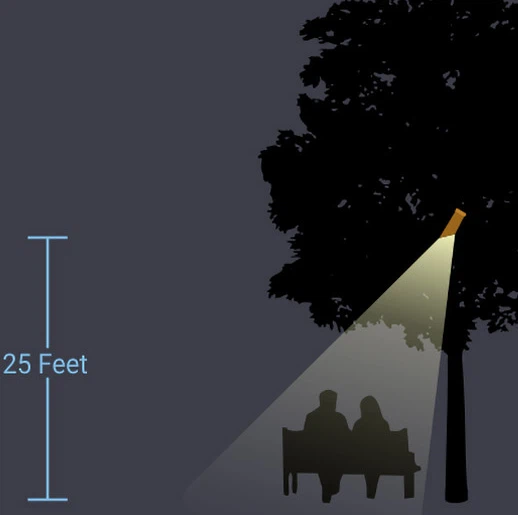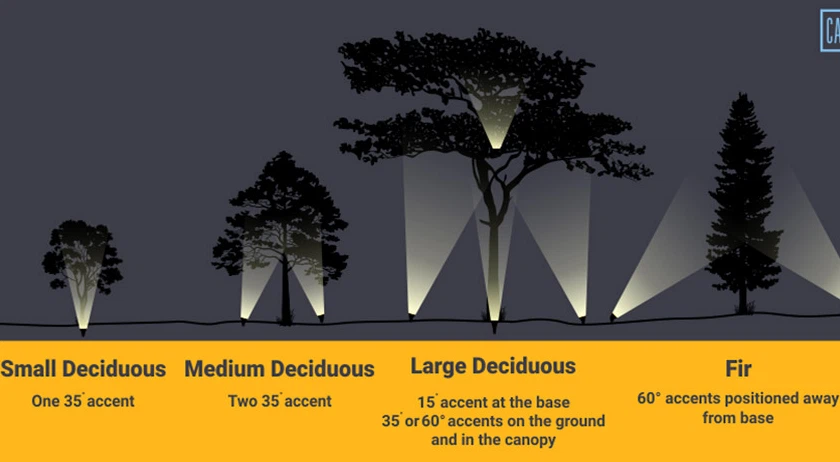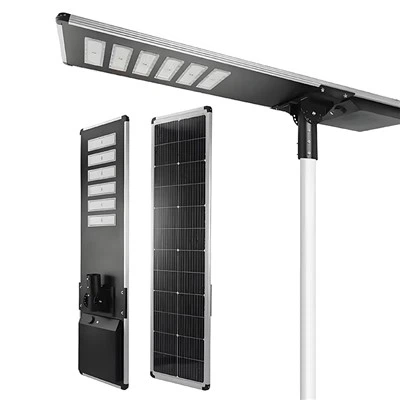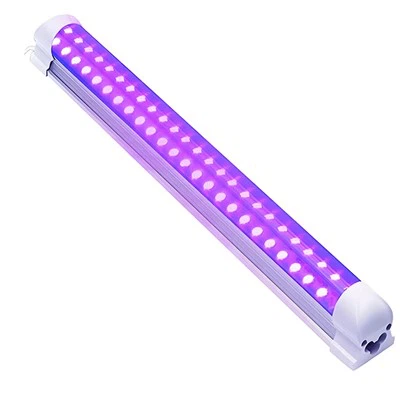Trees may be illuminated in two different ways. You may either employ downlighting, which is the reverse of uplighting, which shines the light downward. Your strategy will be based on the outcome you want to achieve.
The basic ideas behind uplighting and downlighting trees are covered in this article. We'll talk about the various methods and the kinds of trees that can be uplit or downlit.
How to Downlight a Tree: Downlighting involves shining the lights downward. To give the earth a dappled appearance, utilize downlighting. The concept of downlighting will become clear if you consider how moonlight creates lovely shadows.

Deciduous trees benefit from downlighting the most. For such dappled shadows, a large canopy would be ideal. With a dense canopy, conifers cannot use downlighting. The lighting fixture need to be placed at least 25 feet above the ground. In this manner, a huge region is illuminated.
Since, downlights are best mounted on tree trunks and substantial tree branches. The lighting fittings are simple to conceal in certain places. Downlighting works better with low-voltage LED lights since they are more energy-efficient.
Additionally enhancing the security and safety of your yard are downlights. This is crucial because big trees may cast shadows and create gloomy areas. These may help burglars build hiding places.
The size, form, and intended impact of the tree will determine how many downlights you require. Two lights per tree, on average, seem to work. To get those lovely ground shadows, try shining a light through some branches.
Lighting fixtures used for uplighting trees direct light upward. Uplights are often put at ground level to illuminate trees. The optimal location is close to the base of the tree, with the lights pointed towards the trunk and lower branches. This will provide a striking appearance that highlights the height and texture of the tree.
The positioning of the lighting fixtures is determined by the kind, height, and breadth of the tree. A few lighting arrangement ideas are shown in the picture above.
Depending on where they will be situated, you must make sure your uplights provide the appropriate quantity of light. To help you get the most out of your tree uplighting, consider the following lumen output advice:
What Kind of Lumens Are Required to Uplight a Tree?
Since the primary goal of this project is to uplight your trees, the required lumen output will vary depending on the height of your trees.
The right lumen output is required. You want to quietly light the tree. This will provide a pleasant atmosphere. You lose this atmosphere when the light is too bright. It might seem eerie when there isn't enough.
The potential of blown-out topics or eye fatigue brought on by excessive output is eliminated by flawless output. Additionally, it prohibits employing a light level that is too low and failing to see a feature.

Here are some broad pointers for striking the ideal balance:
Level 1 (80–120 lumens): This level, which has the lowest lumen output, is ideal for illuminating areas up to around 6–10 feet above the ground. Smaller trees may thrive at this light intensity, which also suits plants like hedgerows, bushes, and shrubs as well as intricate structures like sidewalks, decks, and porches.
amount 2 (140–180 lumens): Medium-sized trees do best with this amount of lighting. On two-story houses, you may also utilize it to provide a shadow effect.
Level 3 (230-270 lumens): If your environment has larger trees, level 3 lighting is definitely necessary. This amount of illumination is also appropriate for multi-story and bigger residences.
Use level 4 lighting (350–1000 lumens) to illuminate chimney tops and conspicuous house peaks as well as 50–80 foot tall oak and pine trees.
Learn more about lumens and landscape lighting by reading this article.
Finally, depending on the size and density of the tree canopy, you may want to think about cross-lighting your trees. A tree's cross-lighting may help soften harsh shadows.
Cross-lighting further produces a three-dimensional impression that emphasizes the texture, form, and color of a tree. Therefore, if your trees can be seen from different angles, you may utilize many lamps on the canopy and one lower-level light on the tree trunk.
Where Should I Concentrate My Attention When Lighting a Tree?
Even if you use the greatest uplighting fixtures available, if you don't direct the light beams in the appropriate directions, you won't get the desired lighting, security, and safety effects.
The breadth and dispersion of the light are determined by the beam angle, which has an impact on how the tree appears and feels in the surrounding area.
Here are a few things to remember:
To generate a wash effect and get rid of brilliant spots and dark regions, use low, broad beams of light.
For a dramatic impact, a narrower beam angle is needed for smaller trees.
For accentuating certain tree characteristics, such as the trunk, branches, or leaves, narrow beam angles are appropriate.
Wide beam angles are great for downlighting trees since they illuminate more relevant regions, such as the ground underneath the tree or neighboring structures.
It's better to set up lighting fixtures in the ground and then angle them to concentrate on the trees and the surrounding surroundings since uplights create a shadowing effect.
Depending on the size, shape, and intended impact of the tree, the ideal beam angle will vary. Until you get the ideal balance, you may experiment with various light positions and beam angles.
Landscape lighting: Halogen vs. LED Why Light a Tree? Choose LED.
You've come up with the ideal design, beam angles, and light levels, and you're wondering whether to use LED or Halogen lighting. The answer to LED is a resounding yes. This is why:
Since LED bulbs last 10–20 years compared to 1-2 years for halogen, using LED lighting can save you time since you won't need to replace the bulbs as often (which may be challenging with downlights).
Since LED bulbs consume up to 80–85% less energy than halogen lights, you'll save energy (and more money!).
Compared to halogen bulbs, LED bulbs are more robust and can survive inclement weather such as rain, wind, and severe temperatures.
Since LED bulbs are less likely to fail or malfunction, they also become simpler to use and control with time.
With LED lighting, you also have additional possibilities for personalization since you can alter the brightness, color, and direction of the light.
To find out more about LED vs. halogen lights, read this article.
Are you prepared to brighten your landscape, including the lovely trees you have there? Get in touch with us; we'd be pleased to share our knowledge and experience with you so you can design the perfect landscape lighting scheme.






